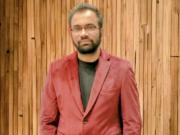
As a versatile graphic designer with a passion for voxel art, Fengyi Liu explores a wide range of techniques and mediums, showcasing his adaptability and passion for innovative design solutions. As a graphic designer at Native Foreign, an Emmy-grade creative agency, Liu is dedicated to experimentation and learning, which allows him to cultivate a unique approach to design and artistic expression.
Q: What led you to graphic design?
A: My journey in design began with a deep curiosity for visual storytelling and a desire to express my thoughts and observations through creative means. I worked at a student media organization during my undergraduate and focused on newspaper typesetting and layout. This experience fueled my passion for graphic design. Later at ArtCenter, I had the privilege of learning from knowledgeable and inspiring instructors who guided me into the world of design. I was continually inspired by my peers, as we worked together and exchanged ideas. This enriching educational experience ultimately led me to pursue my career in graphic design.
Q: Can you share one of your most impressive projects?
A: The project that consumed the most of my time is Arkive. One deliverable from the Arkive project is an interactive installation that serves as a repository for memories. In essence, it is a continuing exploration of a memory preservation prototype that I had previously developed in my earlier projects. The initial idea for this concept came when I witnessed some friends successfully reviving various artworks through 3d reconstruction approaches. This experience motivated me to design a digital ecosystem where individuals can edit and store their memories, as I believe that memories are what make us alive. They shape our identities.
Q: How is this interaction device built?
A: The device consisted of two interfaces with supporting wooden racks on the back, and two projectors connected to my computers. This allows the content I create on my computers using a software application called MadMapper to be projected. Additionally, I also had a setup that included a knob-shaped sensor connected to an Arduino board, which was interfaced with my computer, all housed within an antique radio structure. I removed the internals of the radio but placed the chip into the sensor. When the sensor is rotated, people are able to see the changes in the timeline as well as the images and stories from different old times in that region.
Q: Your editorial design Downbeat Reimagined is also Gold Winner for the 2023 Muse Awards. Where did you get your inspiration from?
A: I started the redesign by conducting extensive research to understand the reasons for the changes and identify possible improvements based on user experience. My first discovery was that the current visual design did not resonate with their target audience and felt outdated. I re-categorized the magazine's audience into classic jazz community, jazz education, and student jazz group, and then explored different approaches for logo, format, and content design. I also used jazz album cover designs as references, and ultimately, I settled on this duotone style of visual system.
Q: Can you share one project that you participated in at your current company Native Foreign?
A: I had the opportunity to be part of the team working on an OpenAI-sponsored animation project Critterz. This project served as a testament to the potential of collaboration between creative professionals and AI technology, as it marked the one-year anniversary of Dall.E 2.0. Working on this project allowed me to explore the innovative and experimental aspects of combining human creativity with AI. I was constantly inspired by the outcomes we achieved. The experience of working on Critterz really made me appreciate the possibilities that AI offers in enhancing our capabilities and the desire to continue exploring this fascinating area.
Q: How would you describe your style?
A: My design style consists of improvisation and a unique visual language. I draw inspiration from core principles of clarity and readability, blending storytelling with creative experimentation. At the same time, I keep the focus on the cultural and industry context of each project. This multifaceted perspective allows me to produce visually striking and conceptually rich work that resonates deeply with the viewer while remaining relevant within its context.
Q: In your opinion, what sets you apart from other graphic designers?
A: My perspective is heavily influenced by my personal experiences and interests. I believe that graphic design can lead the viewers to absorb ideas perfectly. I enjoy wandering around the city and I find the quiet charm of antique stores appealing. The artifacts from different eras demonstrate the intricacy of design and mechanical ability. The lasting impression left by these machines gave me insight into the impact of printing. This connection to the past influences my design philosophy and inspires me to create pieces that balance contemporary appeal with timeless elegance.









